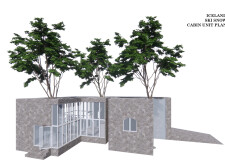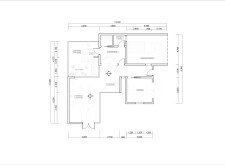5 key facts about this project
# Ski Snow Cabin Unit - Iceland
## Overview
The Ski Snow Cabin Unit is located in Iceland, strategically positioned to enhance its natural surroundings while providing a functional living space. The design emphasizes sustainability, practicality, and integration with the landscape, reflecting contemporary architectural practices that prioritize environmental harmony and modern living standards.
## Spatial Organization and User Functionality
The layout of the cabin is designed to maximize usability, providing distinct functional areas that cater to the needs of outdoor enthusiasts. It features a cozy living room with a fireplace, an open kitchen and dining area that fosters social interaction, and private sleeping quarters that evoke comfort while maintaining a connection to nature. The flexible, open-concept arrangement supports various activities, from relaxation after outdoor pursuits to hosting gatherings. Included within the plan is a maintenance garage, addressing the practical needs for winter sports equipment storage.
## Material Selection and Environmental Integration
Material choices reflect durability, sustainability, and a commitment to aesthetic coherence with the natural environment. Natural stone, specifically limestone or basalt, lines both exterior and interior walls, contributing to insulation and weather resistance while echoing the rugged landscape. Extensive use of glass enhances natural light penetration and provides unobstructed views of the surroundings, establishing a visual dialogue between the interior and exterior. Wood elements, aligned with local construction traditions, may incorporate sustainable timber for structural and finishing details. Concrete, likely utilized in foundational aspects, offers stability, and steel fixtures are employed to ensure structural integrity against harsh climatic conditions.
The design's unique feature of integrating existing trees not only enriches the aesthetic of the cabin but also contributes positively to air quality and the local ecosystem. Additionally, the inclusion of an indoor garden promotes biophilic design principles, connecting occupants with nature and enhancing the overall ambiance. These elements, combined with careful site planning and optimal material selection, exemplify a thoughtful approach to architecture in a challenging environment.





















































